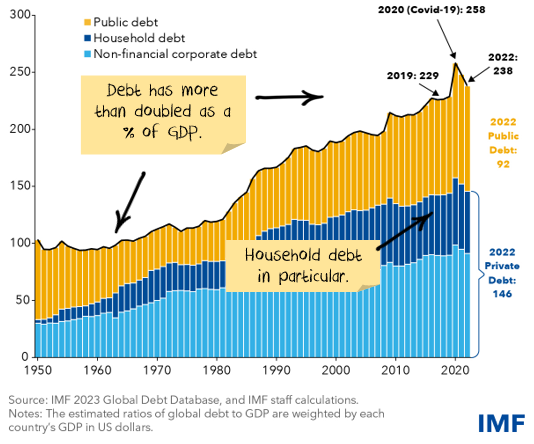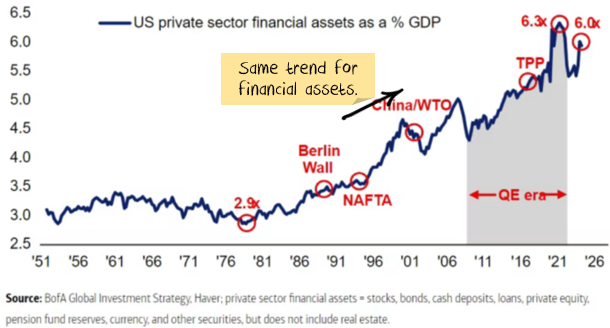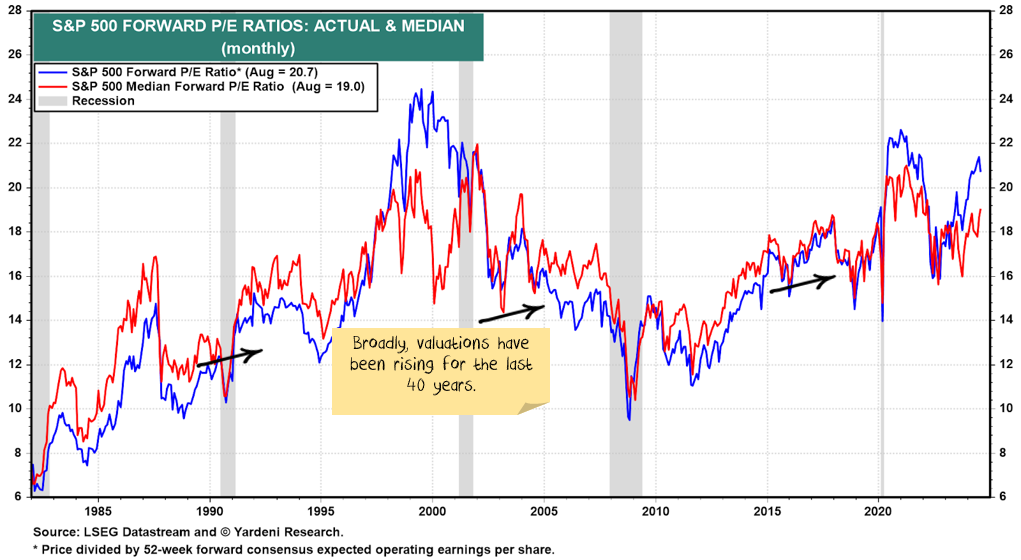There are a lot of “potential” investors on my mailing list. Waiting for the right entry point into the market. Some have been there for almost a decade, watching, waiting and hoping that market valuations will revert to average. Stuck on the sidelines. The question is whether valuations should be structurally higher and interest rates structurally lower due to excess capital. Should investors wait for markets to revert to below-average valuations? Or will we never get there?
Importantly, I want to highlight that I’m not commenting on short-term opportunities in the next week or month but on medium-term investing strategies.
The signs of excess capital
We live in a world of assets and liabilities. Debt, however, is not one-sided: a corresponding asset is created by taking out a loan. Which is why rising debt is one sign of increased capital:
Global debt has risen from 100% of GDP to around 250% over 70 years. Private debt has also surged, with household debt now accounting for about 50% of GDP. While the line looks to be falling at the end, you can ignore that. The absolute level of debt is still rising; the improvement in the ratio is because the denominator, GDP, fell and then recovered post-pandemic. There is no break yet in the long-term rising trend.
Suppose we broaden the definition to financial assets, including stocks, bonds, and private equity. The growth is even more significant, from 300% of GDP in the 1950s to 600% today.
The ‘Buffet Ratio’ compares stock market valuations to GDP. Markets are six times higher than in the 1980s on that measure. Excess capital is everywhere.
Inequality is also important.
The simple version is that if you give a rich person an extra $1,000, they will invest it, while a poor person will spend it. The pandemic brought this to the fore. Government support programs for poorer people saw a surge in demand that fuelled consumption and eventually inflation.
But that has now reversed, and we are back to the 50 year trend of increasing inequality. More money to the rich = more investment = excess capital.
Return on capital. Long-term = critical, short-term = meh.
Over the long term, valuations fluctuate. What is important is the return on the capital invested. A 2% per annum higher return over 25 years means a 64% increase in returns.
Wealthier countries generate more excess capital, often leading to higher stock valuations but potentially diminishing returns. Historically, stock markets offered 6-9% returns; with more capital pursuing the same opportunities, will these returns decrease over time?
But, in the short term, valuation multiples matter more than returns. Suppose the market goes from a 10% discount to a 10% premium over a year. In that case, a 2% difference in return on capital is a rounding error vs the stock market return.
If there is too much capital chasing too few opportunities, valuations rise.
If the absolute dollar value of profits is still rising (largely they are), we can take it one step further.
Say the return on stock markets is expected to be 8%, comprised of a 3% yield and 5% growth in cashflows.
Say there is too much capital, and the long term return should fall to 7%. If profits don’t fall, then prices will need to rise until the future returns look like they will be 7% rather than 8%. Which is essentially what they have been doing:
The irony is, if we expect lower future returns because of too much capital (and profits not falling), then we should be buying in front of the change as valuations rise.
Creative destruction is a vital variable.
What can go wrong with the above? One of the key assumptions is that profits accrue largely to existing companies.
Say we live in Destructalia, a country with lots of startups and creative destruction. Then, maybe the lower returns come because of a wave of new entrants funded by the excess capital compete away the incumbents’ profits. The new companies compete for staff, raising wages and shifting the value capture from capital to workers.
Compare that to Protectalia, say, a country with relatively weak antitrust, oligopolies, and captured regulators. Central banks rush to prevent bankruptcies at the slightest whiff of contagion. Then, existing companies can use regulation and political support to protect profits. They can buy disruptors before they do any damage to margins, and the status quo is maintained.
I’ll argue we are more like the second than the first.
Technology
Technology also plays a role. Rapid increases in technology (like we are seeing now) often concentrate wealth in the hands of a few. It shifts the power from workers to companies. It also leads to excess capital.
Central banks know the world has been financialised.
The Victor Schvets argument is that financialisation, where more money is funnelled into financial markets, drives consumption and capital expenditure:
There is abundant capital and policy tools to smooth such ructions, and the highly financialised, highly indebted world we’ve created means it is in no one’s interest for bubbles to pop – not highly indebted governments, not highly indebted households, and not the central bankers and policymakers charged with ensuring stability.
Central banks are now caught needing to defend markets, as a dramatic drop in stock markets can now trigger a downward economic spiral. On the flip side there is the opportunity for an upward spiral of rising markets supporting economic growth.
The question is how to invest in that world.
Despite arguments for market overvaluation, there is still an argument for investment if capital influx continues. If:
- Inequality keeps rising
- Global debt keeps rising
- Technological changes mean companies capture more upside than workers
- Existing companies (with the help of regulators and politicians) keep most of the profits
Then you probably want to be carrying more equities in your portfolio than you otherwise would have, despite the higher valuations.




